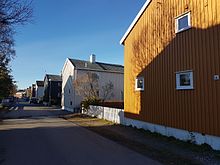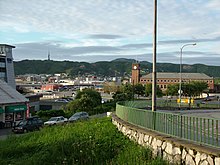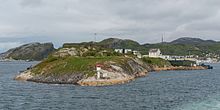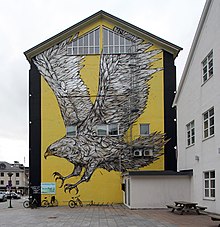Bodø
| coat of arms | map | |
|---|---|---|

|
|
|
| Basic data | ||
| Commune number : | 1804 | |
| Province (county) : | North country | |
| Coordinates : | 67 ° 17 ' N , 14 ° 23' E | |
| Surface: | 1,395.27 km² | |
| Residents: | 52,357 (Feb 27, 2020) | |
| Population density : | 38 inhabitants per km² | |
| Language form : | neutral | |
| Postal code : | 8003-8079 | |
| Website: | ||
| traffic | ||
| Railway connection: | Nordlandsbanen | |
| politics | ||
| Mayor : | Ida Maria Pinnerød ( Ap ) (2015) | |
| Location in the province of Nordland | ||
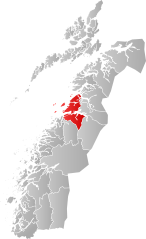
|
||
Bodo [ bu: dɛ ] (trad.) Or [ bu: dø ] (. Liter), Lule Bådåddjo , capital of the province of Nordland in northern Norway and seat of the municipality Bodo.
It is located in the Salten region north of the Arctic Circle . In 1968 Bodin and Bodø merged to form a municipality. On January 1, 2005, the former independent municipality Skjerstad was joined to Bodø. In 2016 Bodø was named the most attractive city in Norway with the award for sustainable urban development awarded by the Norwegian Ministry of Local and Regional Development. In 2024 Bodø will be one of the three European Capitals of Culture alongside the Austrian city of Bad Ischl and the Estonian city of Tartu .
geography
The city is located at a geographical longitude of 14 ° 23 ′ east from Gr. and a latitude of 67 ° 17 ′. It's at the far end of a peninsula that juts out into the Vestfjord . The polar night lasts from December 15th to 29th, the midnight sun is visible from June 2nd to July 10th. The city has 52,357 inhabitants (as of February 27, 2020) . They live on an area of 1385 km², which is larger than that of Berlin . The annual average temperature is 4.6 degrees Celsius, the average temperature in July 13.6 and in January −2.6 degrees. The highest mountains in the municipality are Lurfjelltinden (1284 m) and Børvasstindene (1176 m). The local mountain for day trips is the Keiservarden (366 m). The largest islands are Landegode (30 km², in the North Sea ) and Straumøya (29 km², on the Saltfjord ).
history
The city was founded on the site, at which time the trading post was Hundholmen. The aim of the foundation was to develop the city instead of Bergen as a trading center for the northern Norwegian fishermen including a trade monopoly and thus to relativize the influence of the Danes (under whose rule Norway was). Bodø prevailed against Vågan and Brønnøy . The founding of the city was delayed by the coalition wars and the associated separation of Norway from Denmark. In 1816, amid strong protests from Bergen, the Storting decided to grant city rights with 60 to 5 votes based on a proposal by Bishop Mathias Bonsach Krogh . On May 20, 1816, King Charles II confirmed this decision.
In 1818 the so-called Bodø Affair came about, a diplomatic conflict between the dual monarchy Sweden-Norway and Great Britain . The cause was the confiscation of various goods (including syrup, tobacco and rum), which the British trading company Everth & Son intended to export duty-free via Bodø to Norway. One of the company's owners, John Everth, was also arrested and interrogated. The Ministry of Foreign Affairs in Sweden at the time, responsible for the Union's external relations, was remarkably lenient with Everth and paid the company compensation in 1821. The conflict damaged the Norwegian trust in the alliance with Sweden and was the subject of the Storting several times until 1829.
Bodø remained relatively insignificant until the 1850s. A census in 1855 showed 255 inhabitants. Bodø experienced strong growth between 1865 and 1885 when large schools of herring came to the coastal region and were caught. In the 1870s it was considered one of the fastest growing places in Norway. In the summer of 1889, Emperor Wilhelm II visited Norway and Bodø with the Hohenzollern , which gave tourism there (and in Lofoten ) a significant boost. The Keiservarden mountain plateau bears this name in his honor. With the construction of the pier and the jetty in 1904, passenger and freight traffic developed, also due to the ships of the Hurtigruten, founded in 1893, which have been docking there since then . At the turn of the century Bodø was the third largest city in Northern Norway after Tromsø and Narvik . In 1900 the population was around 6,000. The city's growth slowed and stabilized between 1900 and 1940.
During the German invasion of Norway and Denmark in World War II , Bodø was attacked by the German Air Force on May 27, 1940 and almost completely destroyed. Therefore, Bodø has only a few historical sights today. Bodø was the Norwegian city that was most destroyed in World War II. The majority of the residents were housed in emergency barracks and homeless shelters until the end of the Second World War.
After the city was rebuilt, a completely different cityscape emerged, which is characterized by a sober and functional style, both in terms of urban planning and architecture. In the western part of the city, a large number of identical detached houses were built in 1941 with the help of the Swedish Red Cross , which today form the so-called Svenskebyen ("Sweden City ").
In 1952 Bodø became a bishopric. In 1957 the cathedral church and in 1959 the town hall were inaugurated. In 1961 Bodø was connected to the Nordlandbahn railway line . During the Cold War , the city was integrated into NATO's military strategy as an air base and the seat of the NATO headquarters of the Allied Forces Northern Norway and was subordinate to the Allied Forces Northern Europe (AFNORTH) regional command with headquarters in Kolsås . The city came into the focus of international politics when on May 1, 1960 the pilot Francis Gary Powers was shot down in the American spy plane U-2 on the flight to Bodø over the Soviet Union .
The two hundredth city anniversary in 2016 was accompanied by an extensive cultural program. Two major infrastructure projects are currently underway (2017): the construction of a 2.8 km long four-lane road tunnel in an east-west direction as well as numerous associated expansion and renovation measures as well as the renovation and expansion of Bodø Airport, which was decided by Storting in March 2017 . At the same time, numerous apartments are being built to relieve the strained housing market.
European Capital of Culture 2024
In autumn 2018 Bodø applied under the title "ARTICULATION" (arctic, art, culture and communication) to the European Commission for the first step of qualification for European Capital of Culture 2024. In September 2019, the decision was made in favor of Bodø, although Norway is not a member of European Union is. Cities outside the EU are admitted after a certain time lag. In addition, Tartu (Estonia) and the Austrian municipality of Bad Ischl will be cultural capitals in 2024. With Bodø, a city north of the Arctic Circle will be the cultural capital for the first time.
coat of arms
The blazon of the Bodø coat of arms reads: In red a faceless golden sun with twelve rays. The city coat of arms was first granted in 1889, the current version dates back to July 24, 1959. The sun represents the midnight sun visible in Bodø in summer. The first version of the coat of arms still contained a reference to shipping and fishing, which are important for Bodø.
economy
More than 30 state authorities and institutions have their headquarters in the city. The economic pillars are therefore the service industry and public administration, the armed forces , health and transport institutions and tourism. The headquarters of Nordlandsbanken and the airline Widerøe are located in Bodø . Bodø is also the headquarters of Nord University , one of the eight universities in Norway.
For some years now, tourism in Bodø has steadily gained in importance. The northbound Hurtigruten ships dock in Bodø at 12 noon every day for three hours, which allows ship travelers to explore the city center. There is a tourist information center in the city center with information in Norwegian, English and German. The repeated mention of Bodø in the Lonely Planet travel guides has been enthusiastically received.
traffic
Hurtigruten ships call at Bodø daily in both directions and also has daily car ferry connections to the islands of Røst and Værøy and to Moskenes in Lofoten . There is a well-developed network of routes for shipping to the islands off the city. Bodø is an end point of the Nordland Railway to Trondheim (day and night trains, travel time approx. 9.5 or 10 hours) with a connection to Oslo and thus the northernmost train station of the Norges Statsbaner railway lines starting in southern Norway . Destinations further north can be reached by long-distance buses . The bus station is in the immediate vicinity of the offshoot of the speedboat ferries (hurtigbåt) to Helgeland (NEX I) or Svolvær (NEX II) in the city center.
Bodø Airport , which was established in 1951 and is also close to the center, has over 1.7 million civilian passengers a year and also serves as a base for the Norwegian Air Force . The airlines SAS , Norwegian , Widerøe and FlyViking fly to almost all major cities in Norway every day. There are also direct flights to Stockholm and, in summer, to popular tourist destinations such as Mallorca and Gran Canaria .
Because of its location at the tip of a peninsula, the road connection is mainly via road no. 80, which connects Bodø with Kystriksveien to the south and with the E 6 in Fauske .
media
The daily newspaper Avisa Nordland (created in 2002 from Nordlandsposten and Nordlands Framtid ) and the media company Bodø Nu (founded in 2001) are based in Bodø. The Norwegian broadcaster NRK also has a district office (NRK Nordland) in Bodø.
Attractions
- The Norwegian Aviation Museum (opened in 1994, extensively renovated in 2017), which is divided into military and civil aviation departments. Famous aircraft such as the Spitfire , CF-104 Starfighter , Ju 88 and the U-2 spy plane are exhibited in the military section . In the civil sector, there are passenger aircraft such as the only remaining seaplane Ju 52 , Twin Otter and F 28.
- The cathedral , built in 1956/1957 in neo-Gothic style with a free-standing bell tower, has 12 meter high glass paintings. It is the seat of Bishop Tor Berger Jørgensen from Sør-Hålogaland-Bispedømme .
- In the immediate vicinity is the town hall, built in 1959, which, like the cathedral, was designed by the architects Gudolf Blakstad and Herman Munthe-Kaas . The town hall was reopened in 2019 after extensive renovations.
- The Nordlandmuseum (Nordlandsmuseet) is located in one of the oldest preserved buildings in the city (1904). It shows the history of the province of Nordland in prehistoric times and in the Middle Ages as well as the city of Bodø. In the open-air department in Bodøsjøen , about 3 km from the city center, 14 historic buildings from the Salten region have been rebuilt and there is an extensive collection of boats. Kjerringøy gamle handelssted is an open-air museum and a trading post with a natural harbor on the coast. In addition, the Nordlandsmuseum maintains other historical places and offers seasonal tours.
- The Nyholmen ski jump on the Burøya peninsula provides information about the history of Bodø during the Napoleonic Wars and as a trading center. Replicas of historical cannons are spread over the entire complex.
- The Saltstraumen is the municipality's largest natural attraction and is located about 30 km east of the city on RV 17 to the south. It is one of the strongest tidal currents in the world. Due to the clean water at this point, the Saltstraumen is extremely rich in fish. Demanding fishing is a popular activity here.
- Bodø is the city of sea eagles . Along the fish-rich waters and on the islands in front of the city are the breeding areas of the largest and densest white-tailed eagle population in the world. The Landego fyr beacon is also located there on the island of Landegode . In the pedestrian zone, the sea eagle is a monument with the sculpture Die Seeadlerfamilie (artist: Skule Vaksvik) created in 1996 .
- About 20 km northeast of the city center is Mjelle strand , a local recreation area with long beaches and a good view of Landegode and bathing facilities.
- Bremnes fort is located between Mjelle and Bodø , a position of the "Artillery Group 510 Bodø" , which was created as part of the construction of the Atlantic Wall and was completed in October 1940. It consisted of several anti-aircraft and anti-sea weapons of various calibres, of which the four largest (Uto C16 L / 45, caliber 150 mm) had a range of 16 km. After the end of the Second World War, the position was used by the Norwegian army until 1994. Today the remains of the positions and bunkers can be viewed.
- Also to the northeast of the city is the Sjunkhatten National Park , which was established in 2010 and is intended to be specially oriented towards the needs of children and young people and is therefore communicated as the “Children's National Park”. It covers an area of approx. 420 km².
- The new Stormen City Library opened in 2014 and the associated concert hall (which together form the so-called Stormen Kulturquartal ) are not only architecturally interesting, but also offer a variety of events and concerts throughout the year.
- There are several private art galleries as well as those run by the Bodø Art Association throughout the inner city. About 2.5 km outside the city center is the Bodøgaard Art Gallery , which is home to a permanent exhibition and changing thematic exhibitions.
In addition, the Nordland Music Festival , a music festival with a classical profile, takes place every summer . The Parken Festival , which takes place annually in August and includes well-known artists in the lineup , is also very popular (2017: including Kygo , Seeb, Franz Ferdinand , 2018: including Zara Larsson , Turbonegro , A-HA , Alan Walker ).
Sports
The city-based football club FK Bodø / Glimt , each three-time cup winner and runner-up in Norway, has been playing in the first Norwegian league, the Elite Series , since the 2017 season . The women's soccer team of the Idrettsklubben Grand Bodø will play in the third division, the 2 divisjon, in 2020.
The men's handball team of Bodø Håndballklubben (BHK) relegated to the third division (2nd divisjon) in 2020.
There are also other handball and soccer teams that are represented in the lower leagues. In addition, some successful winter sports enthusiasts come from Bodø or live there (see below).
Twin cities
sons and daughters of the town
- Leif Aune (1925–2019), economist and politician (Ap)
- Harald Berg (born 1941), soccer player
- Reidar Carlsen (1908–1987), politician (Ap)
- Marianne Dahlmo (born 1965), cross-country skier
- Endre Lund Eriksen (born 1977), writer
- Tore Gjelsvik (1916–2006), resistance fighter, geologist and director of the Norwegian Polar Institute
- Otto Gregussen (* 1956), manager and politician (Ap)
- Jens Petter Hauge (* 1999), soccer player
- Jan Gunnar Hoff (born 1958), jazz pianist and composer
- Jahn Ivar "Mini" Jakobsen (born 1965), football player
- Roger Johansen (born 1977), jazz drummer
- Tore Johansen (born 1972), trumpeter
- Børge Lund (born 1979), handball player and coach
- Geir Lundestad (born 1945), historian and long-time director of the Norwegian Nobel Institute (1990–2015)
- Gry Mølleskog (born 1962), first female court marshal of the royal court (since 2015)
- Willfred Nordlund (* 1988), Norwegian politician
- Adelsteen Normann (1848–1918), landscape painter
- Lene Pedersen (born 1977), ski mountaineer
- Torild Skogsholm (born 1959), politician (V)
- Halvdan Sivertsen (born 1950), songwriter
- Vebjørn Tandberg (1904–1978), entrepreneur and electrical engineer
- Petter Thomassen (1941–2003), politician (H)
Climate table
| Bodø | ||||||||||||||||||||||||||||||||||||||||||||||||
|---|---|---|---|---|---|---|---|---|---|---|---|---|---|---|---|---|---|---|---|---|---|---|---|---|---|---|---|---|---|---|---|---|---|---|---|---|---|---|---|---|---|---|---|---|---|---|---|---|
| Climate diagram | ||||||||||||||||||||||||||||||||||||||||||||||||
| ||||||||||||||||||||||||||||||||||||||||||||||||
|
Average monthly temperatures and rainfall for Bodø
Source: wetterkontor.de
|
|||||||||||||||||||||||||||||||||||||||||||||||||||||||||||||||||||||||||||||||||||||||||||||||||||||||||||||||||||||||||||||||||||||||||||||||||||||||||||||||||||||
Web links
- Official website of the city of Bodø
- Bodø in the store norske leksikon (Norwegian)
- Page about Bodø (Norwegian, English, German)
Individual evidence
- ↑ Statistisk sentralbyrå - Befolkning
- ↑ Kommunal- og moderniseringsdepartementet: Attractive by - Statens pris for bærekraftig by- og stedsutvikling. In: Regjeringen.no. February 8, 2016, Retrieved September 28, 2016 (Norwegian).
- ^ David Nikel: Norway's Bodø Named A European Capital Of Culture For 2024. In: Forbes. Forbes Media LLC, September 25, 2019, accessed September 30, 2019 .
- ↑ Tove Veiåker: 1800 tallet. Archived from the original on December 3, 2013 ; accessed on September 30, 2019 (Norwegian Bokmål, original website no longer available).
- ↑ Axel Coldevin: Bodø by 1816-1966 . Bodø Kommune, Bodø 1966, p. 574 , urn : nbn: no-nb_digibok_2007042401105 .
- ↑ Utviklingen i folketallet 1801-2000. December 3, 2013, archived from the original on December 3, 2013 ; accessed on September 30, 2019 .
- ↑ Bodø’s history in brief . Bodø’s tourist information , archived from the original on September 23, 2015 ; accessed on September 30, 2019 (English, original website no longer available).
- ↑ Programåret 2016. Retrieved April 9, 2017 (Norwegian).
- ↑ Hunstadmoen – Thallekrysset | Statens vegvesen. Retrieved April 9, 2017 (Norwegian).
- ↑ Nå er den clear - Borgerportalen til Bodø commune. Retrieved October 1, 2018 (Norwegian).
- ↑ Bodø becomes one of the cultural capitals in 2024 . Deutschlandfunk.de, September 26, 2019.
- ↑ Bodø - Kommunevåpen Bodø (coat of arms). Retrieved April 9, 2017 .
- ↑ Tourist information. Retrieved April 9, 2017 (Norwegian).
- ↑ Lonely Planet: Bodø - Lonely Planet. Retrieved April 9, 2017 .
- ↑ Bodø hylles nok en gang av Lonely Planet . In: Bodø Nu . February 22, 2017 ( online [accessed April 9, 2017]).
- ^ I grade . In: www.an.no . July 12, 2016 ( online [accessed April 9, 2017]).
- ↑ www.177nordland.no. Retrieved April 9, 2017 .
- ↑ Bodø lufthavn - Avinor. Retrieved April 9, 2017 (Norwegian).
- ↑ Bodø - Store norske leksikon . In: Store norske leksikon . ( Online [accessed April 10, 2017]).
- ↑ Bodø rådhus (Bodø Town Hall) , Arkitekturguide Nord-Norge og Svalbard, accessed on June 28, 2020 (English)
- ↑ Bodø Town Hall / Atelier Lorentzen Langkilde Archdaily, accessed on June 28, 2020 (English)
- ↑ Home. Nordlandsmuseet, accessed April 9, 2017 .
- ^ Website of the Norwegian Tourist Office . Retrieved June 5, 2013.
- ↑ Bremnes fort , Bodø krigshistoriske museum, accessed on June 28, 2020
- ↑ Sjunkhatten. Retrieved April 23, 2017 (Norwegian).
- ↑ Velkommen til Stormen! Retrieved April 9, 2017 (Norwegian).
- ↑ Bodøgaard. Archived from the original on November 4, 2012 ; accessed on September 30, 2019 (original website no longer available).
- ↑ Grand Bodø KVI 1 Norges Fotballforbund, accessed on June 28, 2020


